Even if you are being careful and diligent, it’s still possible for you to run into a pest infestation problem. Although Monsteras are not among the houseplants most susceptible to insects, they can still become infested or suffer from fungal diseases.
Let’s see which are the most common Monstera pests and diseases, how to recognize them, avoid them (prevention plan), and how to get rid of them.
Monstera Pests
The most common Monstera pests are mealybugs, spider mites, thrips, aphids, fungus gnats and scale insects. They feed on nutrient-rich sap plant tissue, damaging Monstera leaves and stems.
The first step to getting rid of a pest infestation is identifying what type of insects is attacking your Monstera plant.
1) Mealybugs
Mealybugs are a very common pest that can be stubborn to eliminate. They feast on the plant’s sap, damaging the plants. You can find mealybugs in the areas where your stems and leaves meet.
Identifying Mealybugs on Monstera
Common signs of mealybug pest infestation include:
- White cottony, web-like substance on the plats (the actual insects). They look like white fuzz balls.
- A clear sticky goo called honeydew.
- Leaves turning yellow.
- Wilting, pale-yellow leaves that begin to fall off.
- Ants on the plant (attracted by the wax coating), especially if your Monstera is outdoors.
- Black sooty substance on the leaves (it comes from ants that hunt for sweet-tasting honeydew produced by the mealybugs, the wax coating).
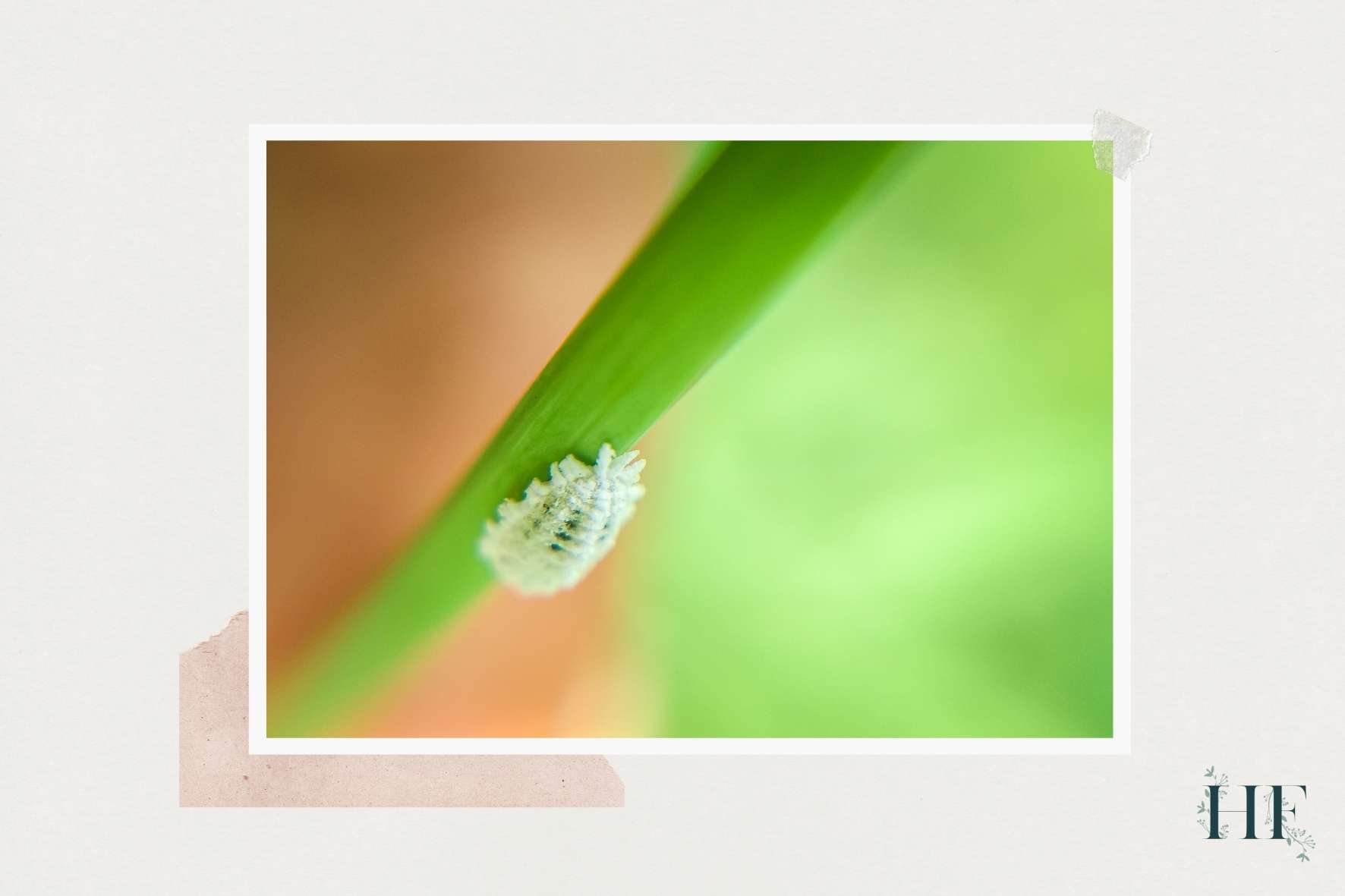
2) Spider Mites
Spider mites are difficult to see without a magnifying device (I use this portable magnifying glass to inspect my plants). At first glance, they look like brown spots until you see them moving!
You can find spider mites on the undersides of Monstera leaves. They look like clusters or small reddish-brown dots.
Identifying Spider Mites on Monstera
Common signs of spider mites pest infestation include:
- Leaf discolouration, the leaves will turn first yellow and then brown.
- Small reddish brown spots, especially in the undersides of your Monstera leaves.
- A clear sticky goo called honeydew (which attracts ants).
- Leaves curl or drop.
There are several species of spider mites, so you may see different colours depending on which type you have. Red and black are the most common types in the US.
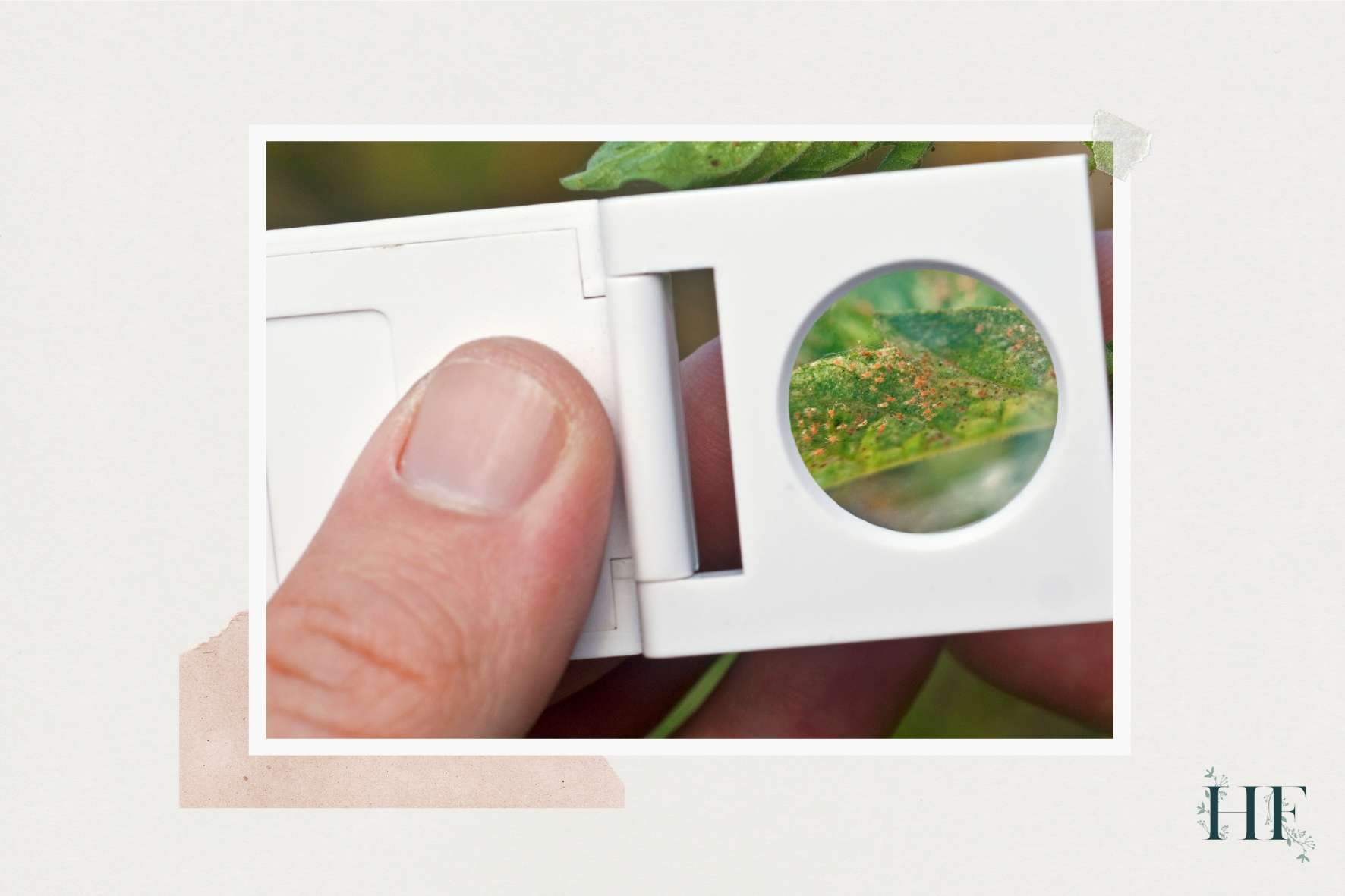
3) Thrips
As adults, thrips are small, light brown in colour, and have tiny wings. As larvae, you can identify them as a white cluster on the leaves or stems.
Usually, you can find thrips on the leaves or stems of your Monstera. But, unless you have a magnifying glass, it’s hard to see their bodies clearly.
Identifying Thrips on Monstera
Common signs of thrips pest infestation include:
- Leaf discolouration.
- Leaves turning brown.
- Leaf dehydration.
- A cluster of white larvae, usually on the underside of leaves.
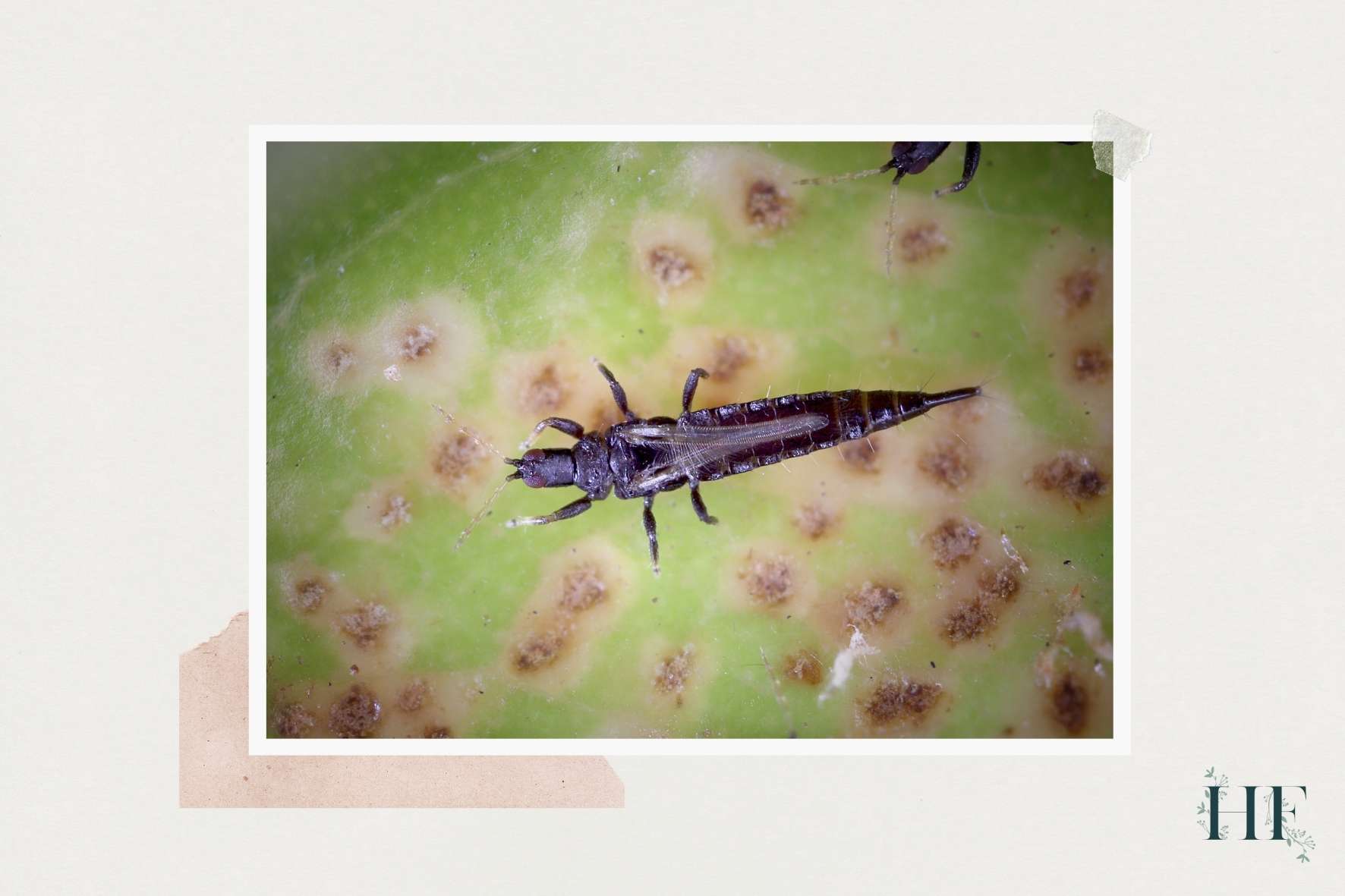
4) Aphids
Aphids vary in colour such as green, white, yellow, brown, red or black; and they might have wings.
You can usually find aphids on new Monstera leaves since they are tender and easier for them to chew.
Identifying Aphids on Monstera
Common signs of aphids pest infestation include:
- Curled leaves.
- Wilting leaves.
- Yellow leaves.
- A clear sticky goo called honeydew (which attracts ants).
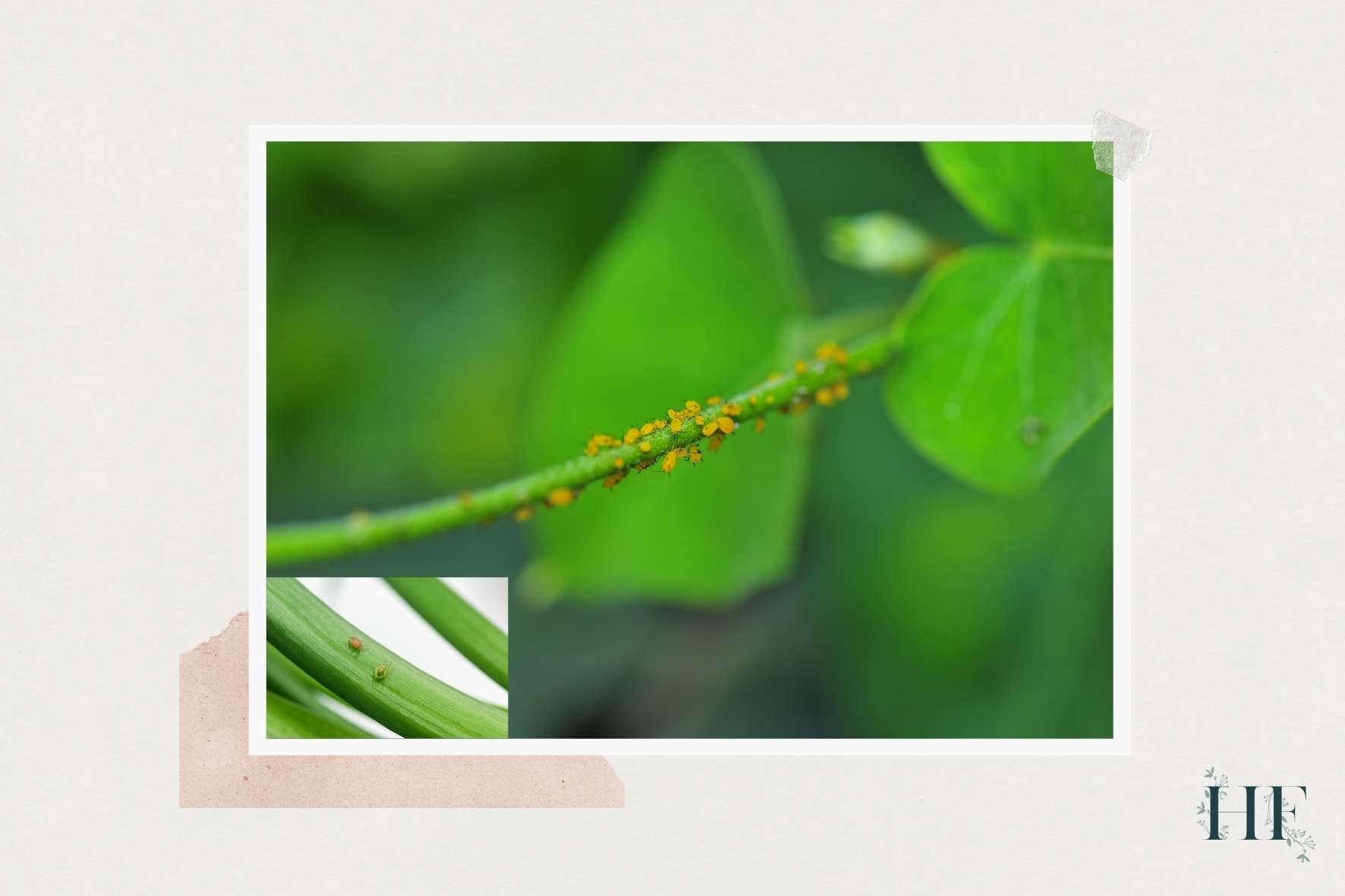
5) Fungus Gnats
If you see tiny, dark-coloured flies flying around your Monstera plant, chances are they are fungus gnats.
These insects appear due to overwatering (i.e., they grow in wet soil). Fungus gnats lay their eggs in potting soil and they feed on organic matter in the soil and also on Monstera roots.
Identifying Fungus Gnats on Monstera
Common signs of fungus gnats pest infestation include:
- Tiny flies on the surface of your Monstera plant’s soil
- Very small flying bugs congregating on the window next to your plant.
- Sudden wilting or loss of vigour.
- Yellow leaves.
- Wet soil.
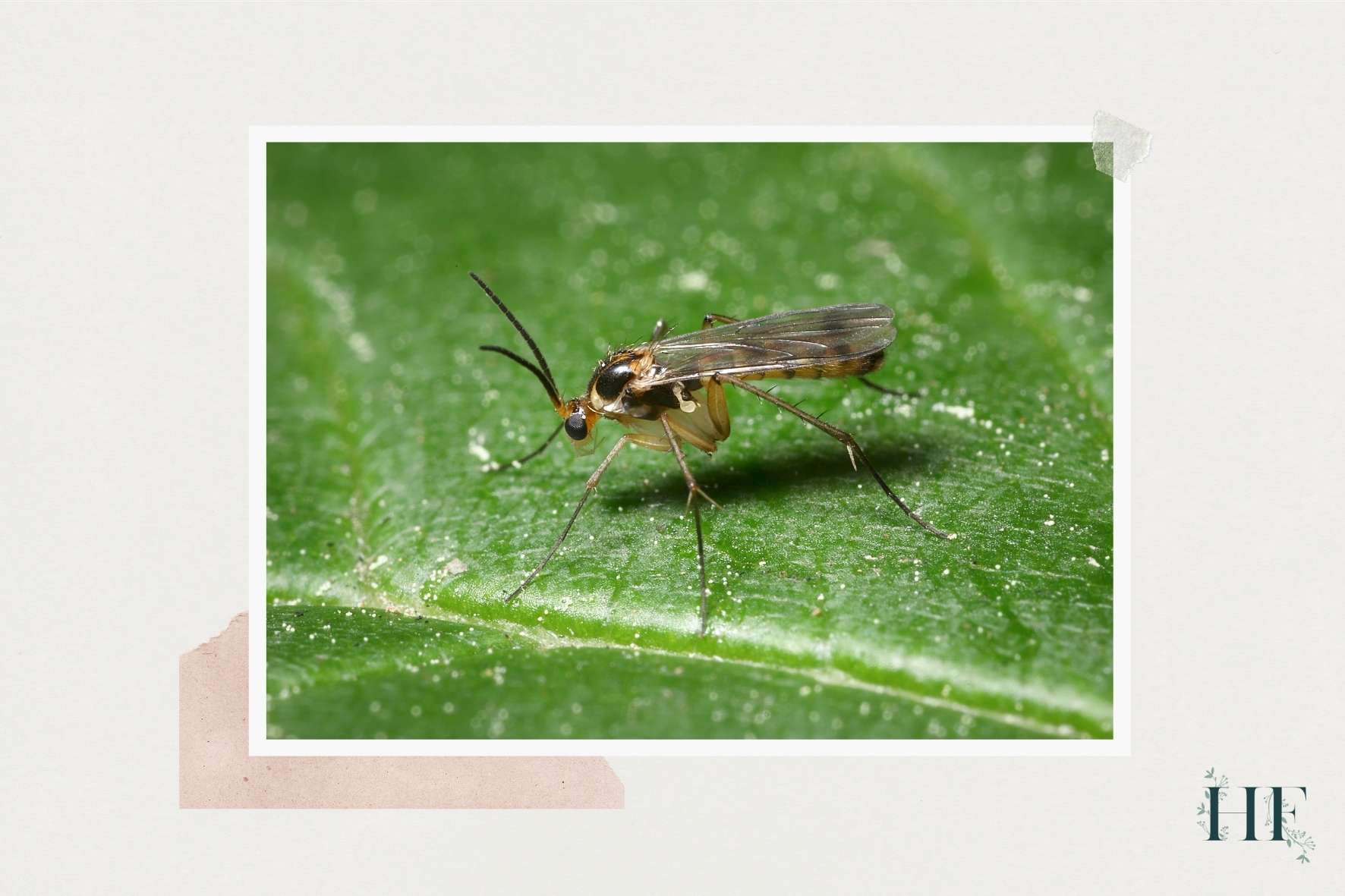
6) Scale Insects
Scale insects attach themselves to the underside of leaves and stems, and feed off of the plant. Although they come in many different colours, they are usually a beige or brown hue.
Identifying Scale Insects on Monstera
Common signs of scale insect pest infestation include:
- Small brown bumps on the underside of the leaves or stems.
- A clear sticky goo called honeydew (which attracts ants).
- Yellow spots on leaves.
- Yellowing leaves that will eventually drop.
- Stunted growth.
Note: Slugs and snails can also be a problem for Monsteras especially if they have been placed outside for the summer.
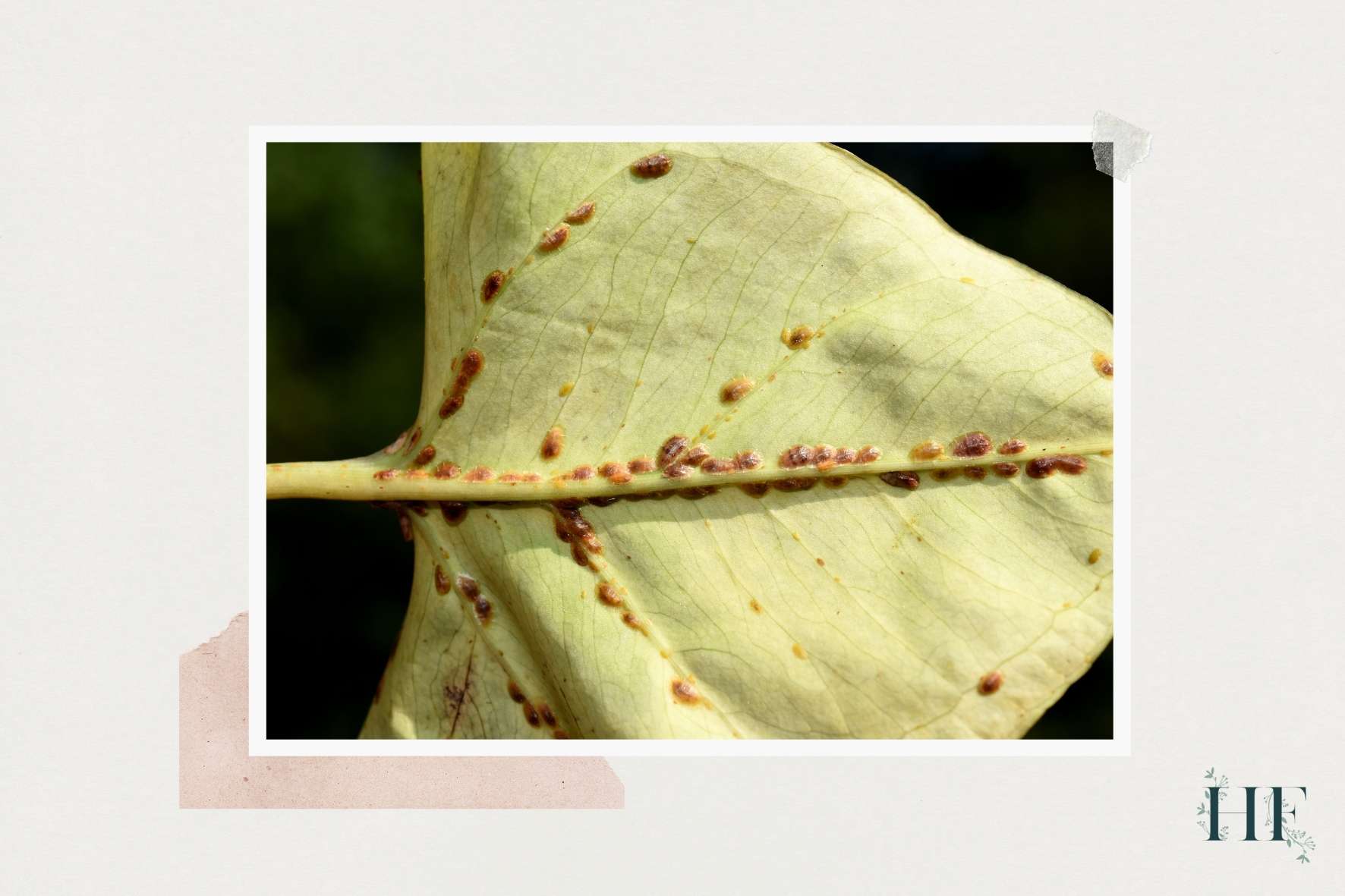
How to Get Rid of Pests on Monstera
First of all, isolate or quarantine your Monstera plant from other houseplants to avoid the pest from spreading to your healthy plants.
Once you have identified the type of pest attacking your Monstera, it’s time to act fast so you can stop the damage and save your plant. Pests, if left unchecked, can eventually kill your plant!
Monstera Pests Treatment Options
There are a few treatment options you can try to get rid of the pest infestation:
1) Physical Removal
This includes manually removing the pests from the plant with your hands or a cotton swab dipped in rubbing alcohol.
Physical removal is feasible if your Monstera has a small pest infestation. Otherwise, it can become a taxing task.
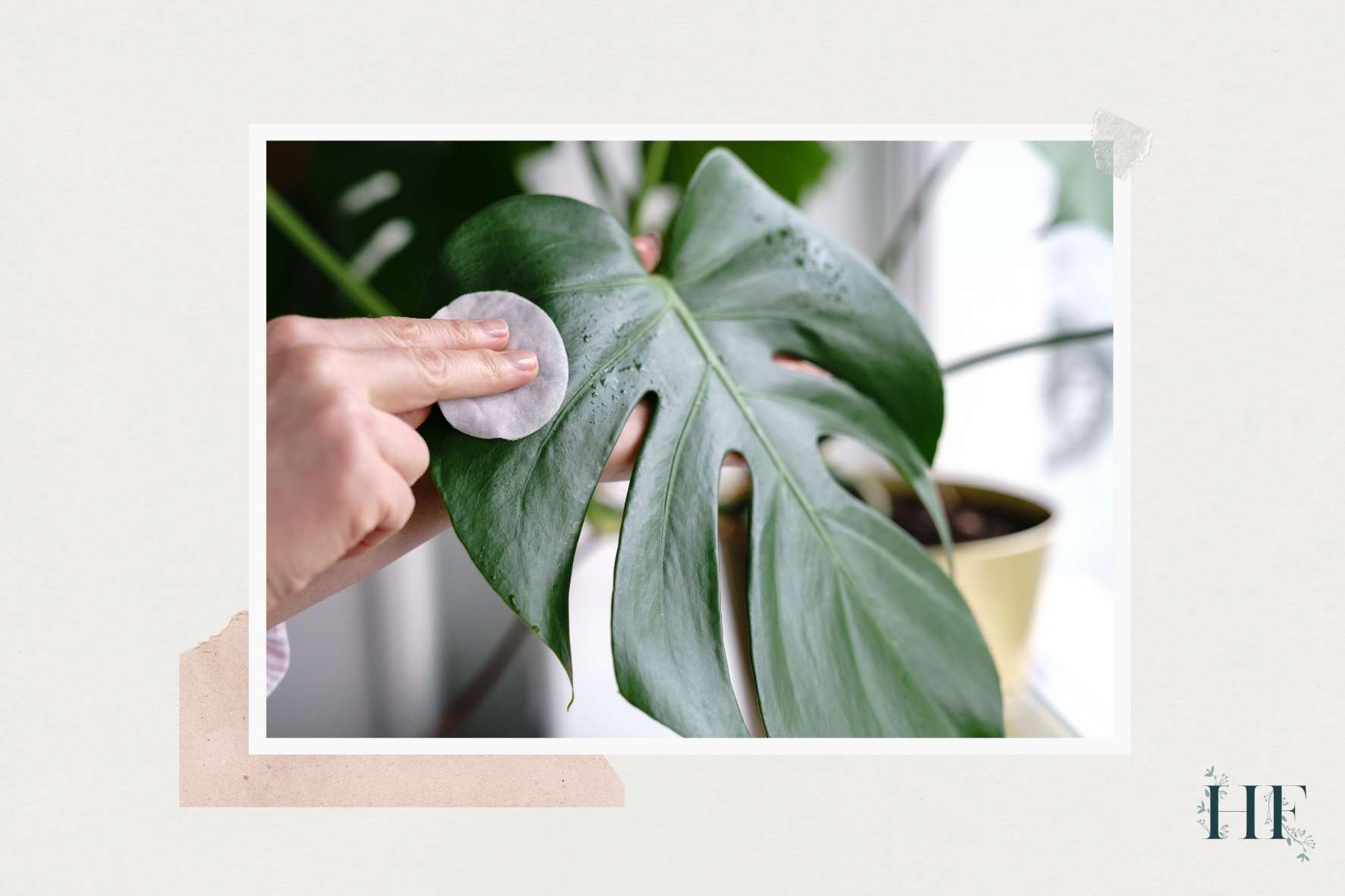
2) Insecticidal Soap
A very effective method is to use insecticidal soap to clean the pest infestation.
Start by preparing your own mixture:
Insecticidal Soap Recipe: Dilute a tablespoon of unscented dish soap (I use this one, which is free of harsh ingredients) diluted in a gallon of water (4.5L).
Then, dip a soft cloth in the solution and clean off the infestation. You can also spray the solution using a spray bottle and wipe the pest off afterwards.
Keep an eye on your Monstera plant for a couple of weeks for any signs of pests before returning it to its regular location.
You might need to repeat the process if the pest infestation doesn’t clear out after the first treatment.
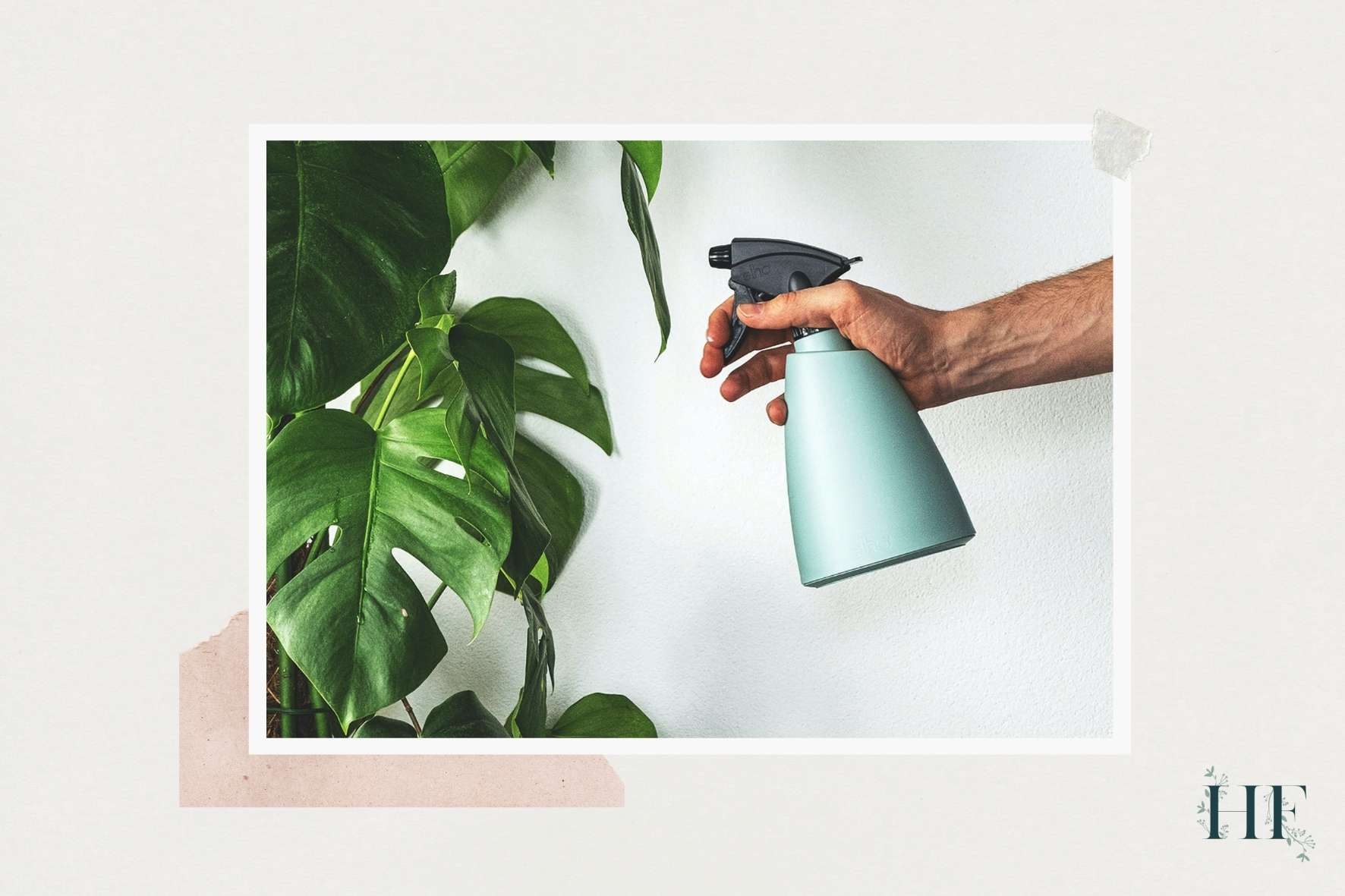
3) Neem Oil
Alternatively, neem oil also works well to get rid of pests. It’s a popular, natural insecticide that works to eliminate stubborn pests and fungal diseases too.
This oil helps with the disruption of the growth and development of insects because it has repellent properties.
Here’s how to make your neem oil mixture:
Neem Oil Fungicide Recipe: To use neem oil as a fungicide, mix a teaspoon of neem oil with a quarter of a gallon (1 litre) of water. Then add a couple of drops of dish soap (I use this one, which is free of harsh ingredients) to emulsify the mixture, and mix well.
Once the mixture is ready, you can apply it with a spray bottle or dip a soft cloth on the mixture and then wipe the affected areas.
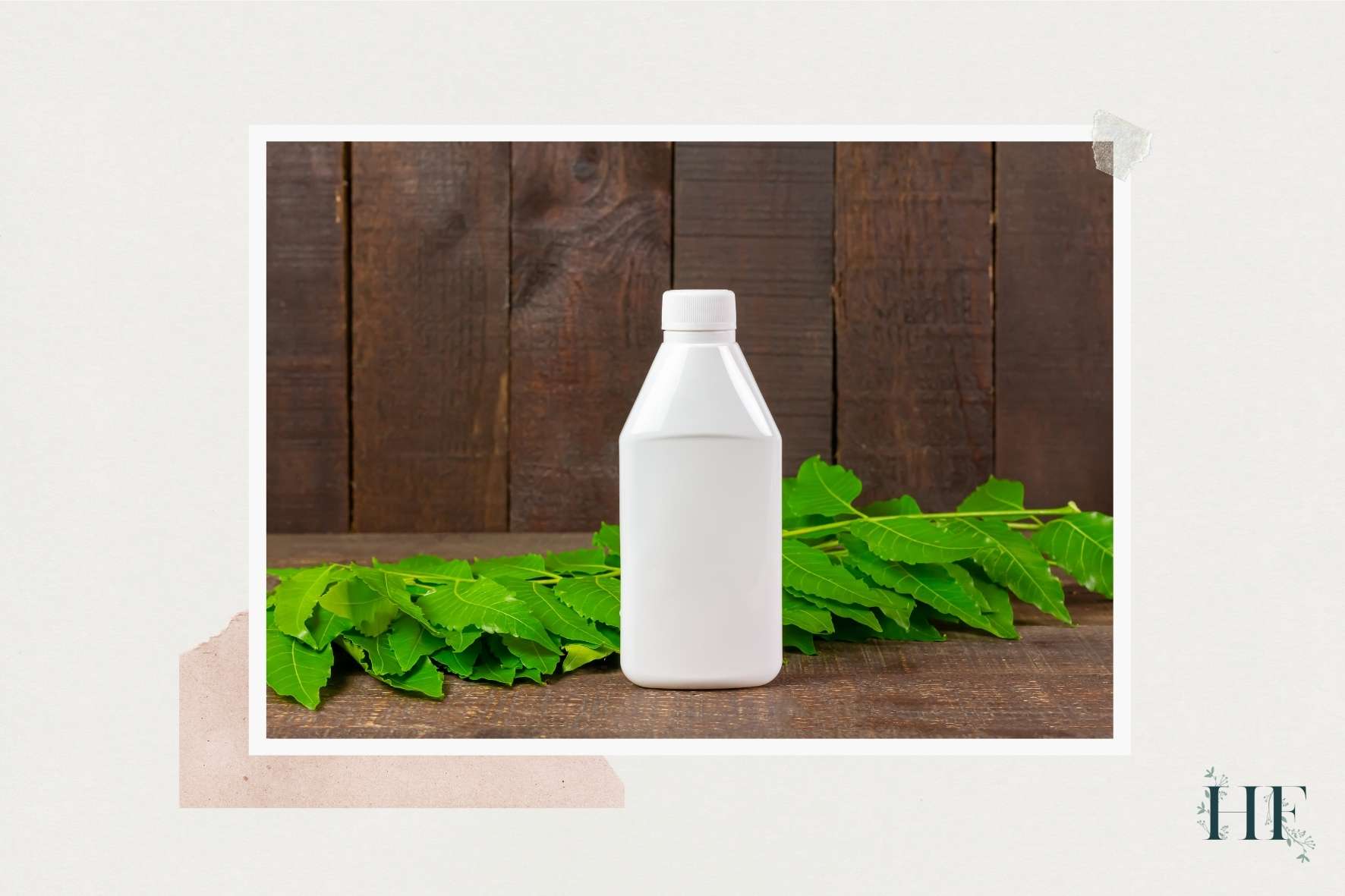
4) Biological Control
This involves using other organisms to kill the pests.
You can also introduce dainty ladybugs, which are natural enemies (predators) of mealybugs, aphids, and spider mites among other small insects. Ladybugs will help to eradicate the pest since they will eat the insects damaging your plant.
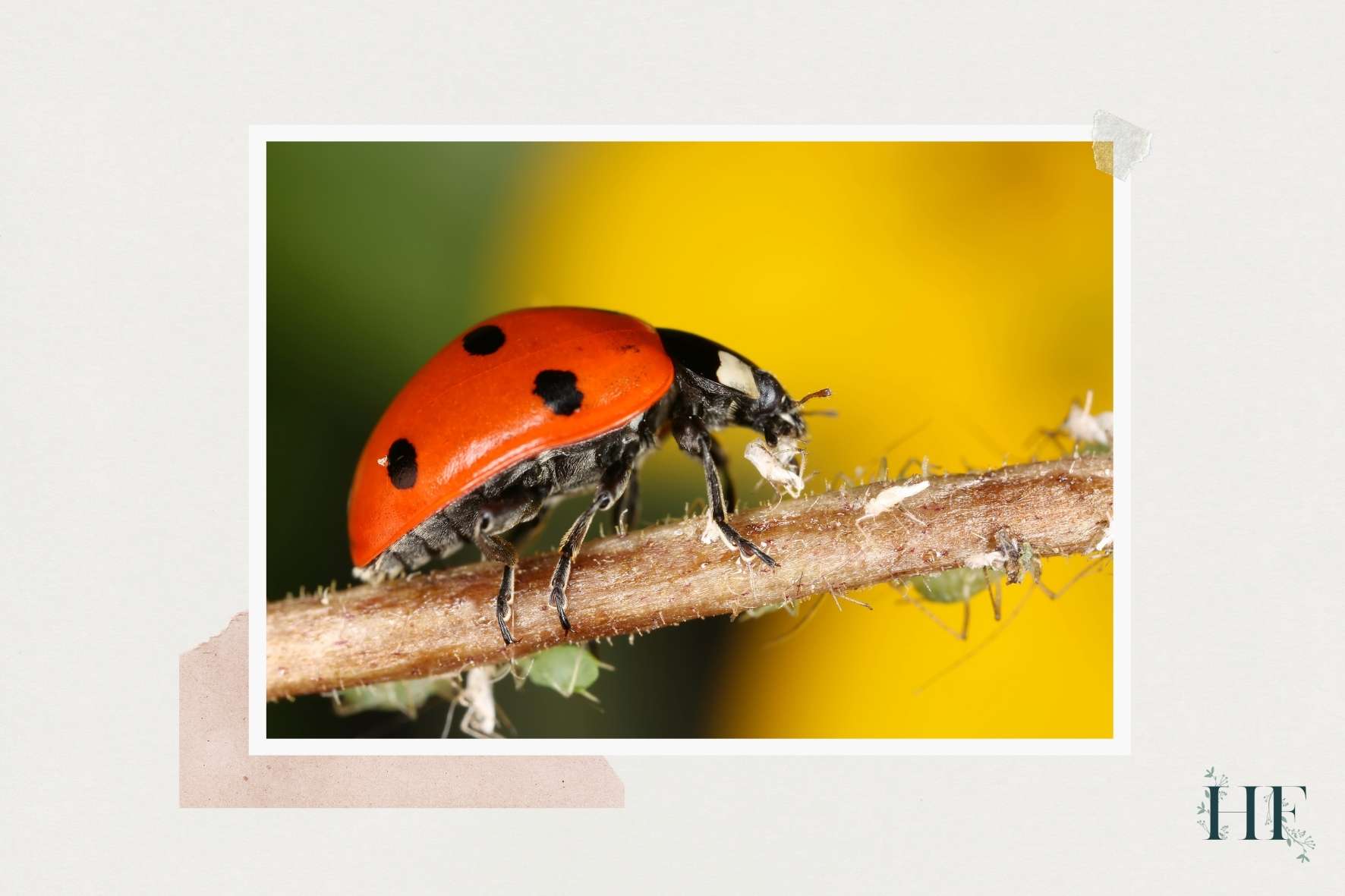
5) Sticky Traps
For flying Monstera pests, like fungus gnats, sticky traps are highly effective.
In the case of fungus gnats, they won’t get rid of the larvae that leaves on the soil, but you will stop the adults from laying more eggs. Then, you can always spray some neem oil mixture into the soil to kill the larvae.
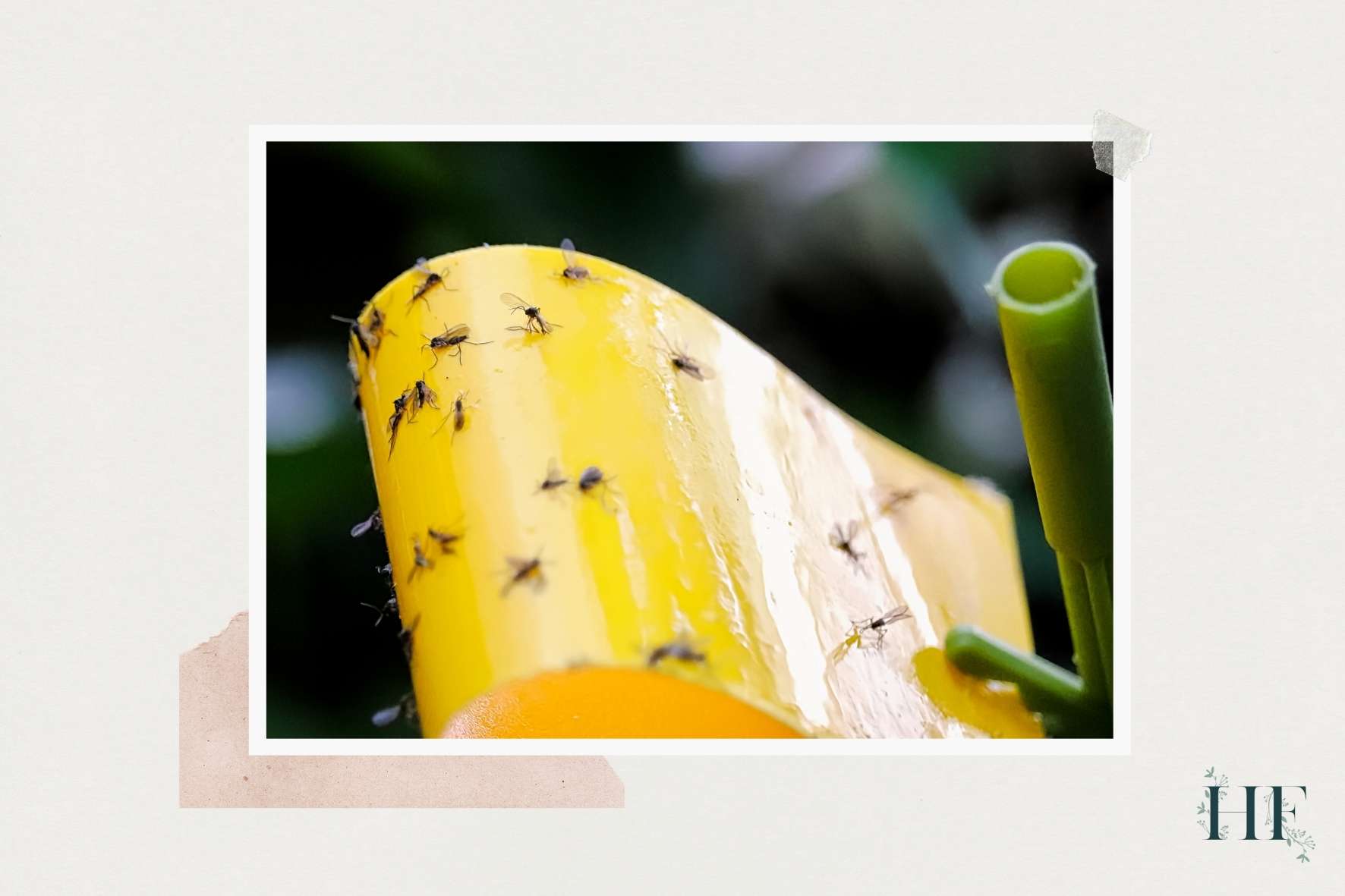
6) Chemical Control
Chemical control is the last resort and should only be used if other methods have failed.
Using a non-organic pesticide is a more aggressive method of eliminating pests and it’s important to follow the manufacturer’s instructions to avoid damaging your Monstera.
Be sure to use a product that is specifically designed for the type of pest you’re dealing with. Also, be mindful of the chemical included in the mix and the fumes they release.
Insider Tip: You might need to repeat either of these treatments until you get rid of the pest infestation completely.
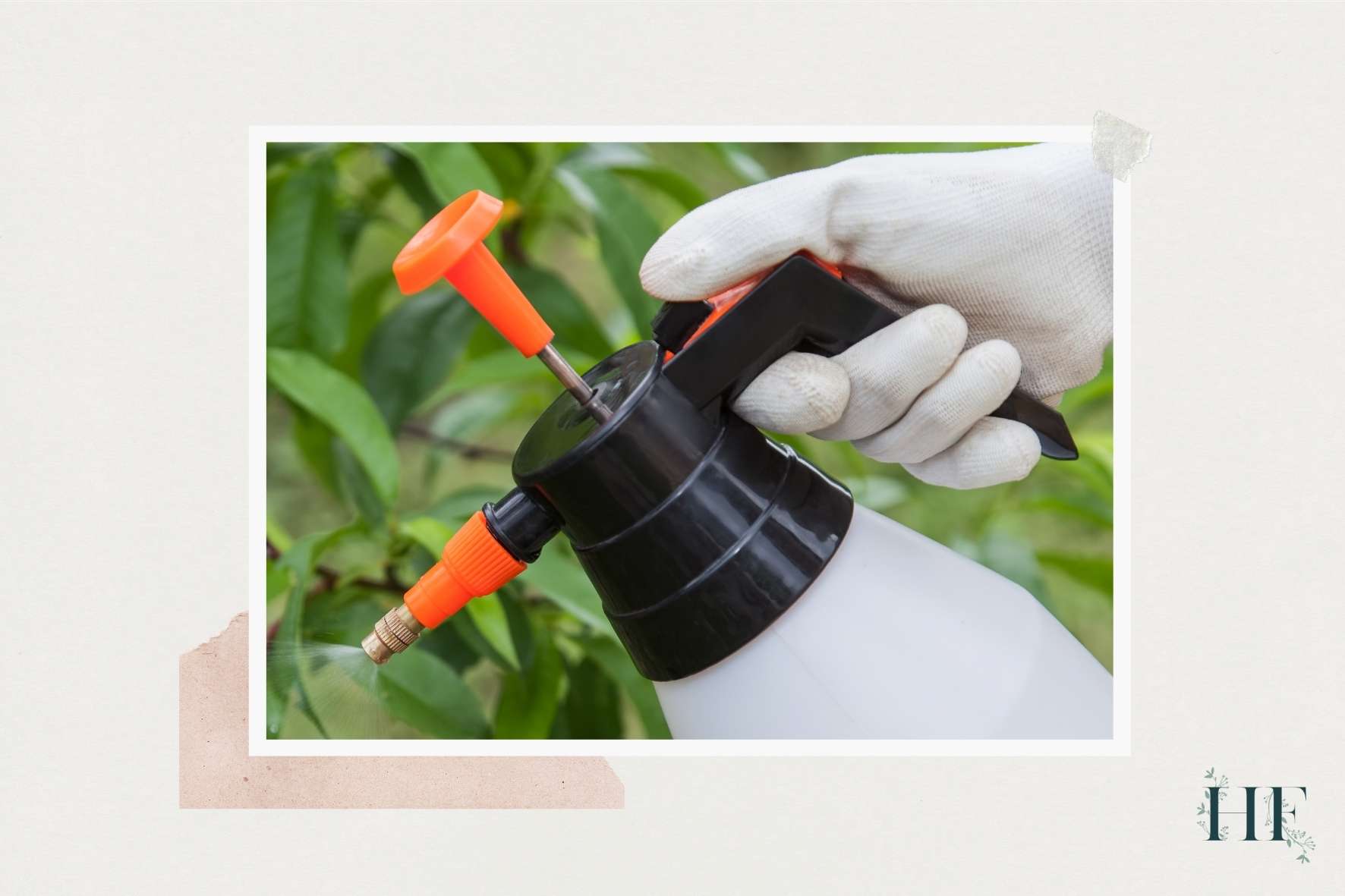
How to Prevent Pests on Monstera
Apart from following an appropriate Monstera care routine, there are a few things that you can do to prevent pests on your plant:
1) Inspect Plants Before Buying
Since insects can spread rapidly between plants in a crowded nursery or flower shop, it doesn’t hurt to check plants before buying them.
2) Quarantine New Plants
When bringing home a new plant, regardless if you bought it in a store or online, keep it away from your other houseplants for a week or two. This time frame will prevent the potential spread of pests and also give any eggs a chance to hatch so you can deal with the problem before it escalates.
3) Use Clean Pots and Fresh Soil
Since fungus and insect eggs can hang around in used pots or potting mix, so make sure to use a new pot or clean the current one thoroughly before using it. Also, make sure to use fresh potting mix so you are not transferring any pests and diseases without knowing.
Read also How to Choose the Best Pot for Monsteras & 10 Planter Ideas and Which Type of Soil Is Best for Monstera?
4) Avoid Overwatering
Many insects are attracted to wet soil conditions, plus fungal diseases thrive in wet environments. So, make sure not to overwater your Monstera plant to avoid attracting unnecessary problems.
Read also A Guide to Monstera Water Needs (How Often and When).
5) Give Your Plant Enough Light
Since lack of sunlight contributes to wet conditions (the soil takes longer to dry between waterings), make sure that your Monstera is getting enough bright indirect sunlight. This will not only help your plant grow healthy but also will keep bugs at bay.
Read also Monstera Light Requirements – How Much Does It Need?
6) Inspect Regularly
Despite your best efforts to prevent pests, they can still find their way onto your Monstera. So, the final tip is to inspect your plant regularly for signs of an infestation. By doing so, you can act fast before the problem gets out of hand!
Outdoor Time
This tip is especially useful if your Monstera spends time outdoors during the summer (this is when your plant goes to the pests rather than the pests coming to it). Regularly check your Monstera when outdoors and definitely inspect it when you bring it back indoors. You might even want to isolate it first before placing it near your other indoor plants.
Read also How to Care for Monstera in Winter – Can I Put It Outside?
Monstera Fungal Diseases
The most common Monstera fungal diseases are root rot, eyespot disease (Spilocaea Oeagina), anthracnose, fungal leaf spots and powdery mildew. All these have the potential to kill your Monstera if not treated accordingly (and rapidly).
1) Root Rot
Monstera root rot is a disease caused by prolonged exposure to wet soil conditions. There are two sources of root rot:
- Overwatering (which creates a wet soil condition).
- Harmful fungi in the soil that thrives on soggy soil.
The soggy soil will create an anaerobic condition (low in oxygen and high in water) in soil that permits disease and bacteria to thrive, which will result in rotten, mushy roots.
There are two main types of soil fungi that can lead to Monstera root rot: fusarium and pythium.
Fusarium is a common soil fungus that thrives on dead or dying plant tissues.
Phytophthora root rot is the most common cause of root and stem base decay. This bacterial organism is commonly transmitted by fungus gnats (which also thrive in consistently moist soil conditions).
Did you know? Spores from these fungi travel through the air and are carried by insects (like fungus gnats). If one of your houseplants has fungal root rot, the fungus has likely travelled to other plants in your home. However, it will not grow or cause damage unless the soil becomes waterlogged.
Identifying Root Rot on Monstera
Common signs of root rot include:
| STAGES OF ROOT ROT | SIGNS OF MONSTERA ROOT ROT |
|---|---|
| Early detection | • Stagnant growth. • Wilted leaves. • Yellow leaves. |
| Advanced root rot | • Brown or black spots on leaves. • Brown or black roots, with a mushy and slimy texture. • Foul odour roots. |
| Beyond saving | • Roots are dead. • Dark and mushy stems. |
It is crucial to know the signs of root rot in Monstera to catch the problem early enough to be able to treat it. The earlier you notice root rot in your Monstera, the more likely it is to survive!
For more, read Monstera Root Rot Signs, Causes and Recovery Tips – which includes Monstera root rot treatment.
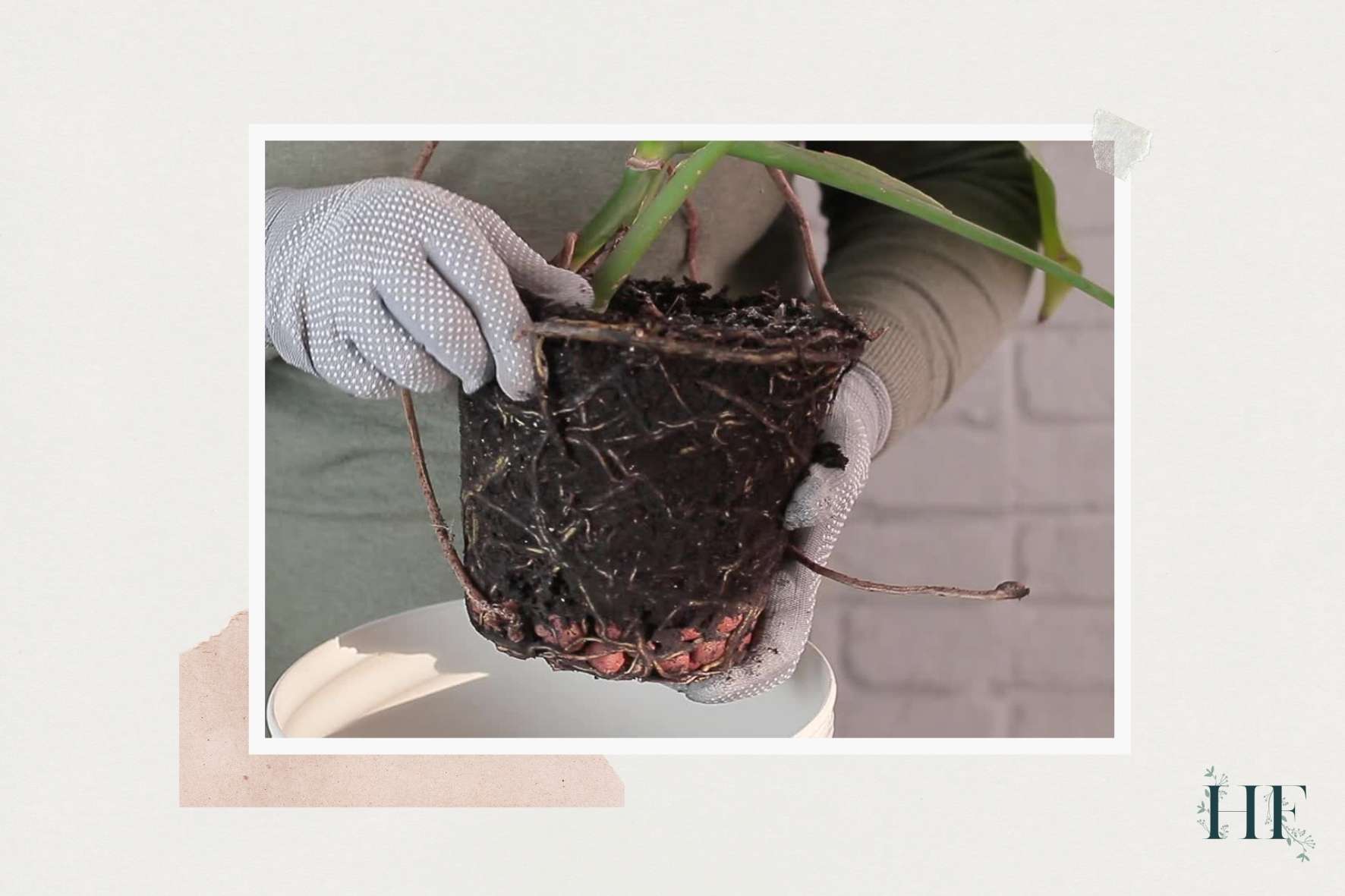
2) Eyespot Disease
Eyespot disease (Spilocaea Oleagina) causes yellow halos or rings around brown spots on a Monstera’s leaves.
This disease is also referred to as peacock eye as the spots on the leaf look similar to eyes.
Identifying Eyespot Disease on Monstera
Common signs of eyespot disease include:
- Brown spots with a yellow ring surround it on leaves and/or stems.
- Leaves are turning yellow.
- Unfurled leaves are affected too.
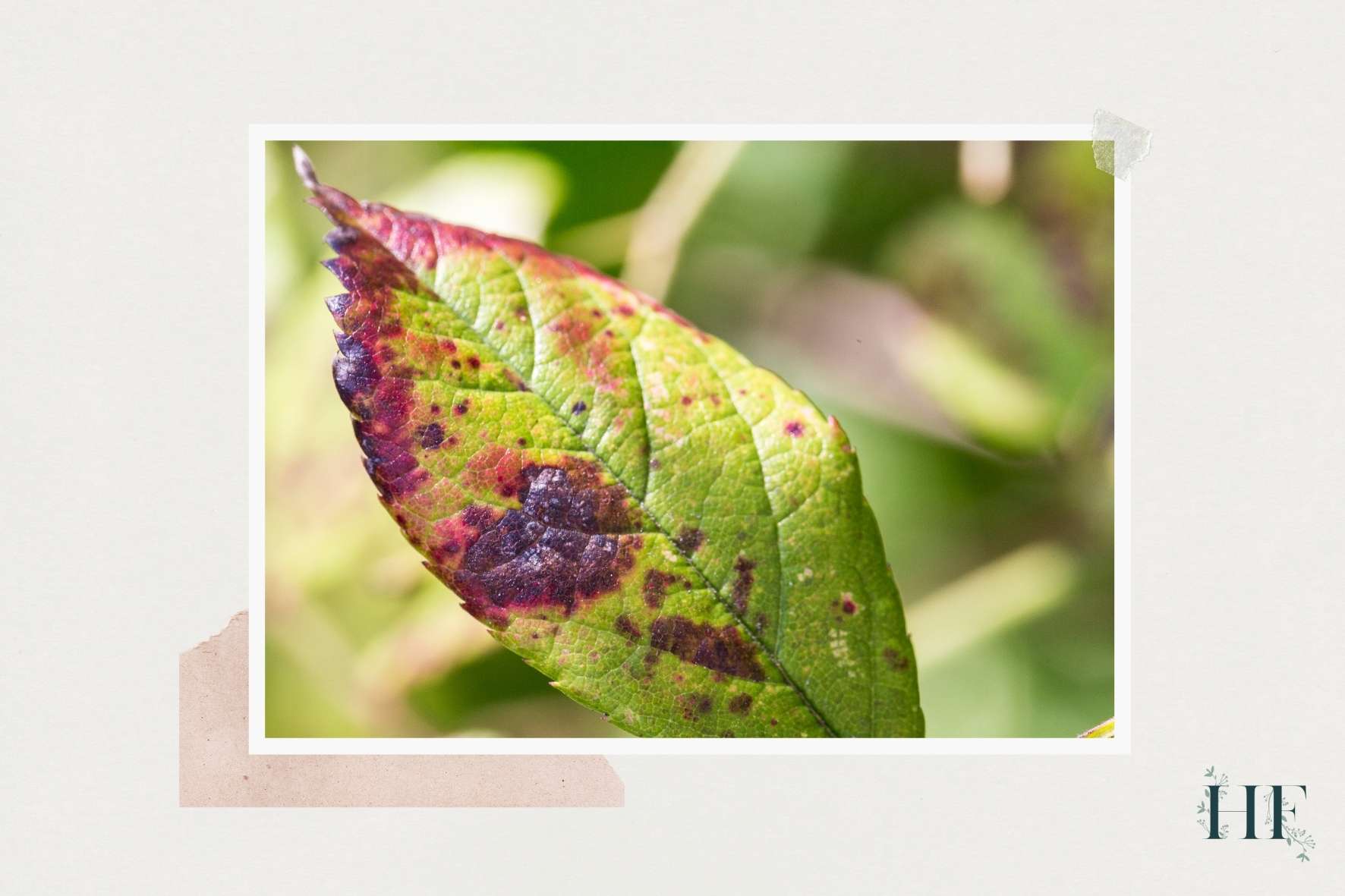
3) Anthracnose
Anthracnose is a fungal disease that starts with yellow or brown spots on the leaves. As the disease progresses, the yellow areas will turn brown, and the splotches will spread.
The discolouration can spread consuming the entire leaf and it can also affect the stem. Also, this disease will spread more rapidly in damp conditions (such as rain or frequent misting).
Identifying Anthracnose Disease on Monstera
Common signs of anthracnose include:
- Yellow or brown spots on the leaves.
- Yellow areas turning brown.
- Spots spread more along the leaves.
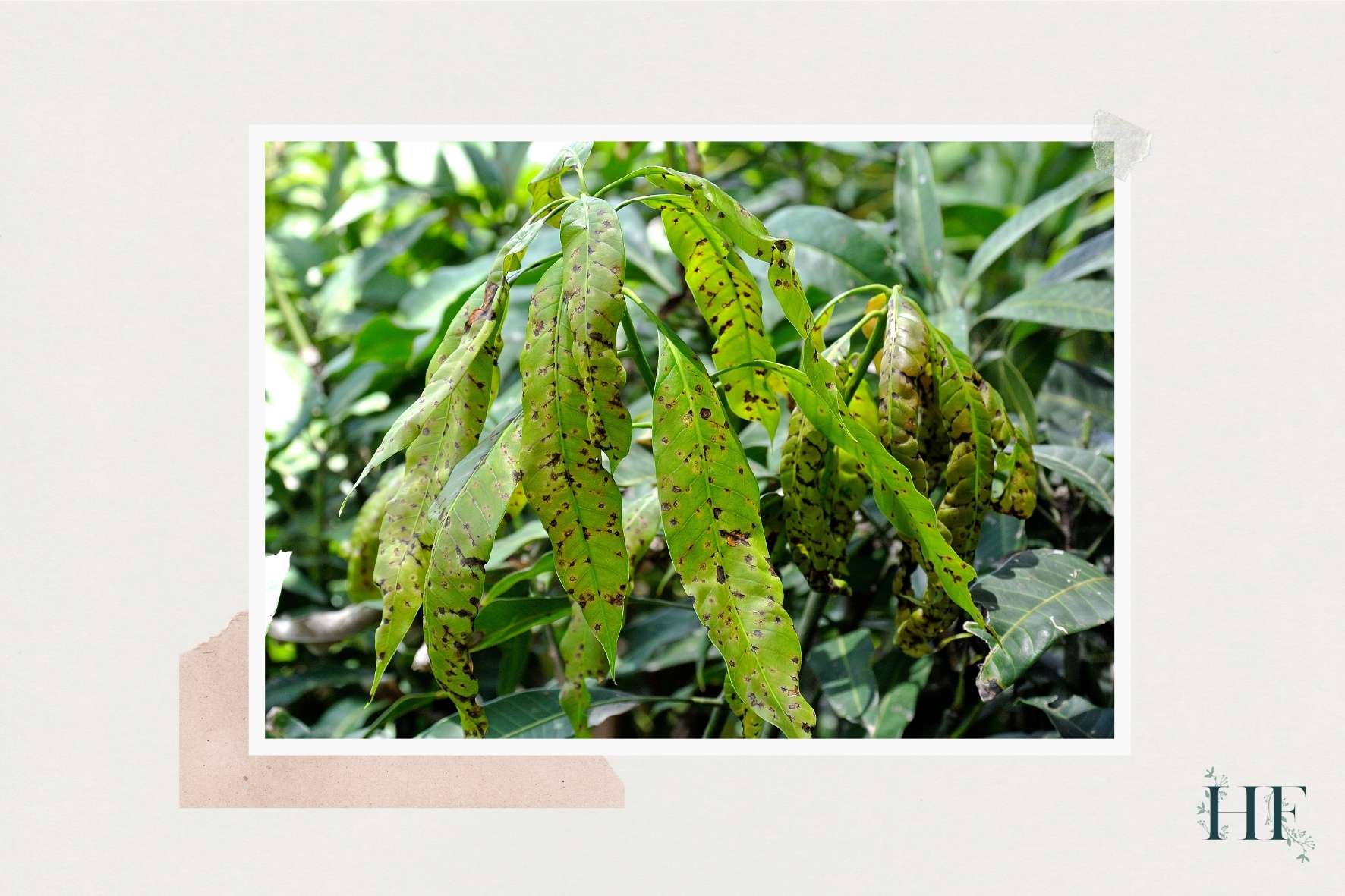
4) Fungal Leaf Spots
Fungal leaf spots happen when a fungus starts to eat away at the leaf from the outside. However, this disease can easily be confused with bacterial leaf spots (which is caused by a germ).
This fungus can cause a cluster of yellowing spots on the leaf and in the centre, there’s a brown or black dot.
Identifying Fungal Leaf Spots on Monstera
Common signs of fungal leaf spots include:
- Irregular brown spots with a yellow ring around them – they can be found on leaves.
- A cluster of yellowing spots with a brown or black dot in the centre – also found on the leaves.
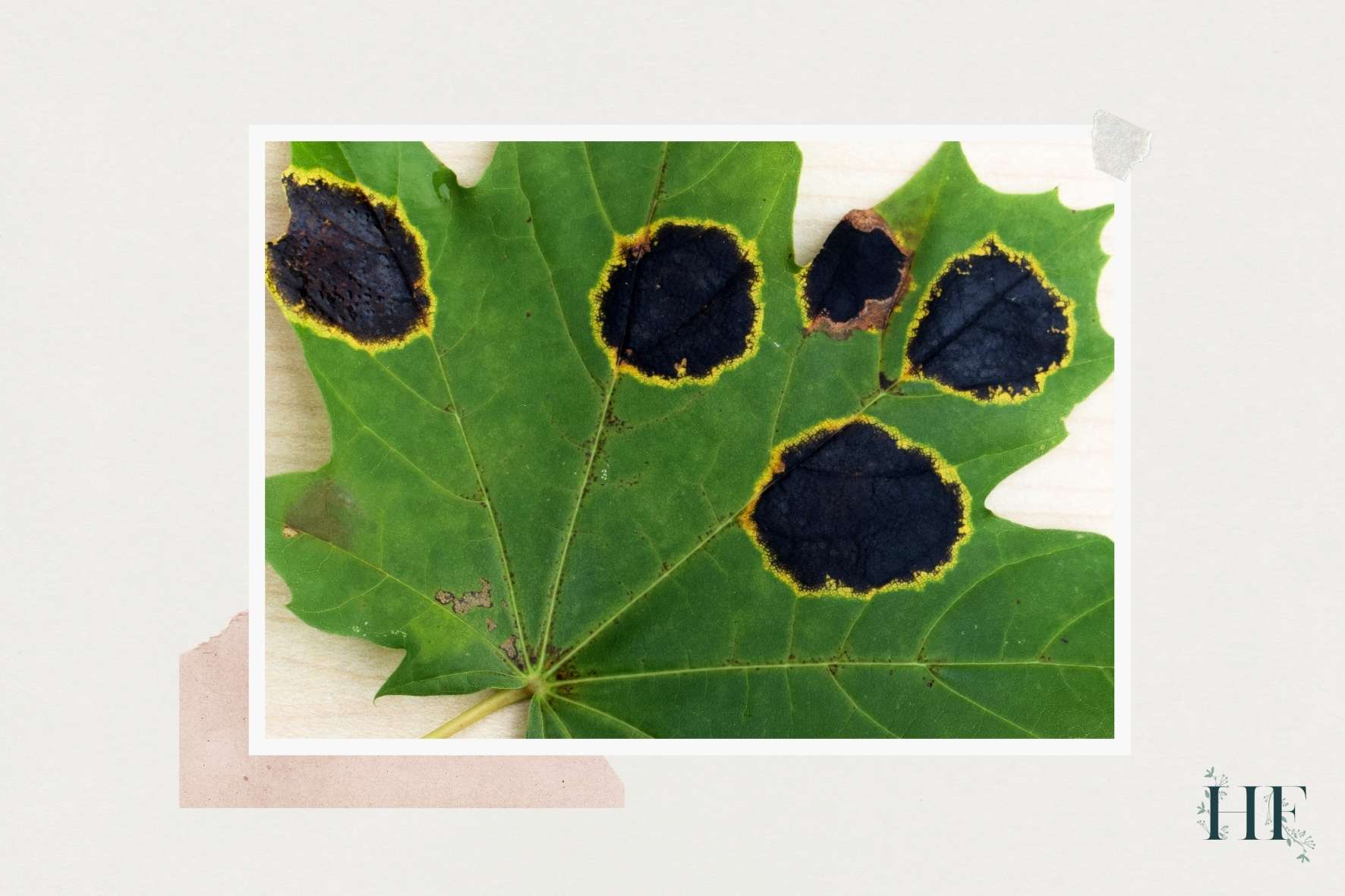
5) Powdery Mildew
Powdery mildew is a fungus that produces a white, powdery-looking coating on the leaf. When left unchecked, this disease will cause the leaves to dry out and turn yellow.
Identifying Powdery Mildew on Monstera
Common signs of powdery mildew include:
- Circular, powdery white spots on the leaves (both on the upper and undersides) and the stems.
- Leaves turn yellow and dry out.
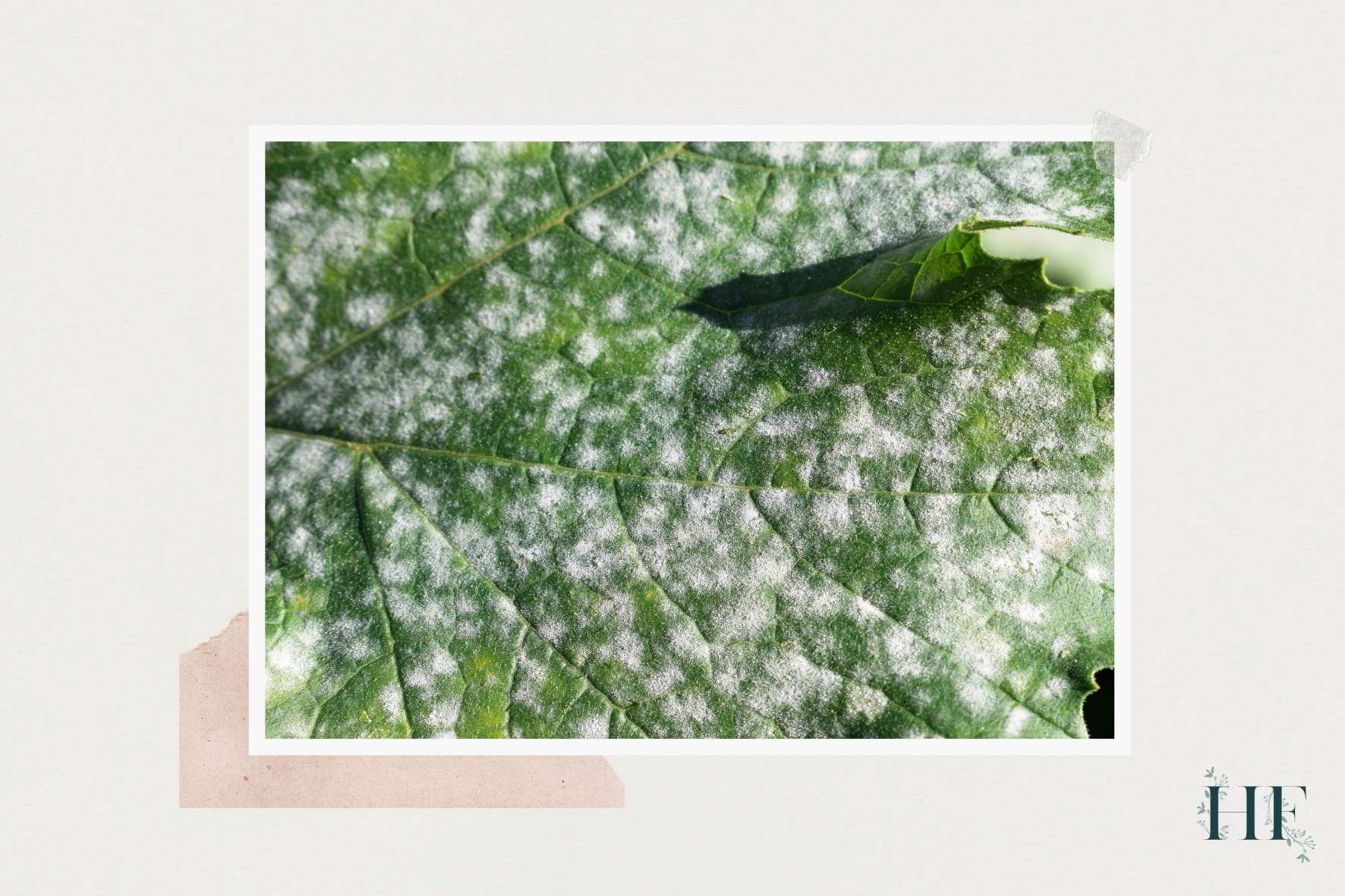
How to Get Rid of Fungal Diseases on Monstera
If you suspect your Monstera has a fungal disease, first isolate your plant from other houseplants to avoid the disease from spreading.
Then, remove the affected leaves and stems using sharp shears that have previously been disinfected. Also, disinfect your shears between each cut by dipping them in white vinegar or rubbing alcohol.
Make sure to discard the infected plant material in the bin to avoid the disease from spreading.
Finally, you can spray your Monstera with a copper-based fungicide (like hydrogen peroxide). This is a type of fungicide that is effective for treating fungal diseases.
Alternatively, you can use a natural fungicide like cinnamon (brewed as a tea) or neem oil (diluted in water – recipe included further down). This last option is very effective and natural.
The treatment options are the same regardless of the fungal disease that is affecting your Monstera.
Insider Tip: By using a fungicide, you can make sure that you haven’t missed an affected area that hasn’t shown signs of disease yet.
Natural Fungicides for Monstera Disease Treatment
If you are looking for a natural solution, you can use the following fungicides:
1) Cinnamon
Cinnamon is a natural fungicide and rooting agent.
Apply cinnamon when treating your Monstera for root rot by dusting it on the freshly washed and trimmed roots.
It will help prevent rot from affecting the healthy tissue, plus it will stimulate new root growth.
2) Baking Soda
Baking soda, or sodium bicarbonate, is another natural fungicide.
When using baking soda as a fungicide, mix three tablespoons into a gallon (4.5 litres) of lukewarm water. Then, spray it into your Monstera’s soil and stems in the evening to help prevent a fungal root rot infection.
Use this remedy sparingly since baking soda is a salt, and too much salt is not good for your Monstera.
3) Apple Cider Vinegar
You can also use apple cider vinegar to combat fungal diseases.
When using apple cider vinegar as a fungicide, mix 3 tablespoons of apple cider vinegar into a gallon (4.5 litres) of lukewarm water and spray it onto your Monstera’s leaves, stem, and soil.
You can use the same apple cider vinegar that you use to dress your salads! 😉
4) Neem Oil
Neem oil is often used to treat pests and fungal infections in plants.
To use neem oil as a fungicide, mix a teaspoon of neem oil with a quarter of a gallon (1 litre) of water. Then add a couple of drops of dish soap to emulsify the mixture, and mix well.
Apply this mixture to your Monstera’s soil after watering. You can also spray this mixture on the affected areas if you haven’t pruned them.
I recommend this neem oil and this gentle dish soap (you probably don’t want to use anything harsh that can further damage your plant!)
5) Hydrogen Peroxide *
Hydrogen peroxide is a bleach and disinfectant that, when diluted, can be used to treat fungal diseases.
*This is the only non-natural fungicide on the list, but since it’s used quite often, I thought it will be useful to explain how to apply it.
To use hydrogen peroxide to treat root rot in Monstera, mix one tablespoon of 3% strength peroxide and one cup of water. I recommend this hydrogen peroxide.
You can dip the remaining roots into a diluted hydrogen peroxide solution or spray the roots with the solution.
| FUNGICIDE | HOW TO APPLY IT |
|---|---|
| Cinnamon | Sprinkle cinnamon powder on roots. |
| Baking Soda | 1) Mix three tablespoons of baking soda into a gallon (4.5 litres) of lukewarm water. 2) Spray the mixture into your Monstera’s soil and stems. |
| Apple Cider Vinegar | 1) Mix three tablespoons of apple cider vinegar into a gallon (4.5 litres) of lukewarm water. 2) Spray the mixture into your Monstera’s leaves, stem, and soil. |
| Neem Oil | 1) Mix a teaspoon of neem oil with a quarter of a gallon (1 litre) of water. 2) Add a couple of drops of dish soap to emulsify the mixture, and mix well. 3) Apply this mixture to your Monstera’s soil after watering. |
| Hydrogen Peroxide | 1) Mix one tablespoon of 3% strength peroxide and one cup of water. 2) Dip the roots into the diluted solution or spray the roots with it. |
How to Prevent Fungal Diseases on Monstera
Fungal diseases thrive in wet conditions, including wet foliage and soggy soil.
If your Monstera is recovering from a fungal disease, avoid using a humidifier or misting your plant for the time being, as dampness left overnight will be an invitation to future fungal infections.
You can prevent fungal diseases by increasing the airflow around your Monstera, especially if you are using a humidifier.
Also, it’s best to mist your Monstera in the morning so the plant has enough time to absorb the water and dry out before nighttime.

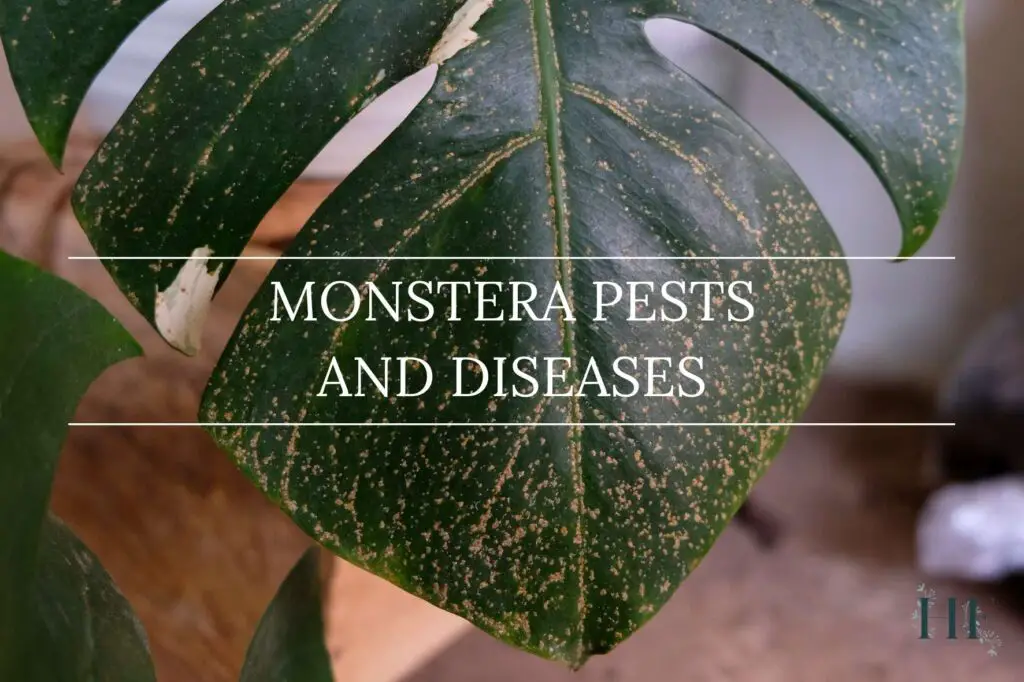
Hi thanks for this article! My monstera plant leaves look exactly like your feature photo, which pest/disease is it?